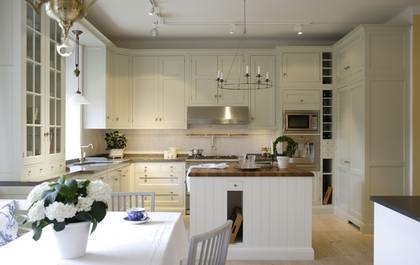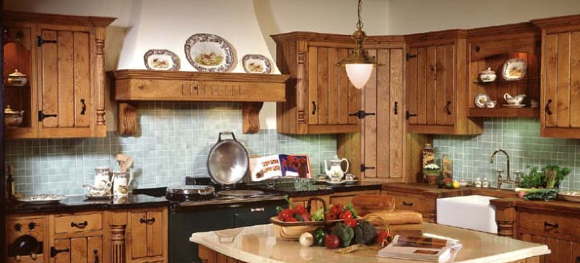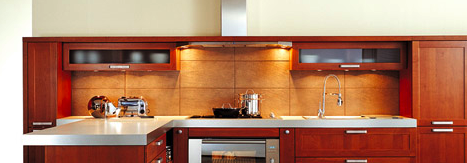When you decide to remodel your kitchen you should start of with having in mind the final look of the finished kitchen. Kitchen types fall into several category, each with its own distinct look to fit the taste of the home owner, be it the traditional look, country or contemporary.
Traditional
Traditional kitchens have formal, elegant looking characteristics of American or European homes of 18th, 19th and early 20th centuries. Expect to see crown and rope moulding, fluting corbels and other ornamentation and trim, cabinets with cherry, walnut and mahogany, raised panel cabinet door styles, antique fixtures and appliances, or wood, stone or other natural materials.

Victorian is a traditional kitchen with cathedral arch doors and raised panels, accented by ornate mouldings and trims. Dark and heavy woods feature on the cabinets.
Italianate is much like Victorian style, the former relying on elegant cabinetry details, especially on the mouldings and trims. It is generally painted cream with intricate raised paneling, and have onlays, rope moulding and custom carved reliefs.
Georgian works in cherry, walnut and mahogany for the cabinets. Square panel raised doors are typical, heavy crown moulding and stacked cabinetry that reach the ceiling are not uncommon. Black accents like a painted black island are also common.
Other traditional styles are Edwardian, Colonial, Farmhouse, Plantation, Regency, Cottage, Cape Cod, Estate, Bungalow, Federal, Queen Anne, Neoclassical, Early American, Manor, and Shaker.
Country
Country kitchens are cheery and welcoming, with light and/or bright colors, painted and glazed cabinets, woven baskets, floral motifs, and decorative shelving and molding. You will normally find floral, checked, striped, gingham and plaid patterns; window and wall treatments in fabrics such as chintz and calico; beadboard wainscoting and paneling; painted, glazed and distressed cabinet finishes; chicken wire or metal cabinet inserts; handmade, hand-forged, homespun look and antiques and flea-market finds.

French Country: Framed cabinets in either raised or recessed panels outfit a room with French country flair. Cherry and oak cabinetry—glazed, distressed or pickled for an authentic finish—reign supreme, though pastel painted cabinetry is also a wise choice. Decorative shelving, the use of beadboard, a butler’s wall or pantry and plate racks will add to the genuine French Country feel.
English Country: Slightly more proper than French country, English country style relies on a square cabinet design accented by curves. To maintain a handcrafted look, light or natural cabinets in pine or oak are prevalent. A sizable wooden mantle range hood, wood cutouts in valances, and intricate crown and rope molding add authenticity.
Farmhouse: The words “wood” and “heirloom” should guide your decorative decisions when creating a farmhouse kitchen. Stained wood, both light and dark, fit in well, though excessive glazing and finishing can create a look that’s a little too complicated.
Cottage: Consider driftwood-like finishes for a seaside cottage feel. If you’re leaning more toward a lake look, a slightly darker (but still natural and wooden) cabinet is your best bet.
Other country styles: Tuscan Country, Swedish Country, garden
Transitional
Transitional kitchens include elements of both traditional and contemporary design. They mix natural and man-made materials as well as finishes and textures for that eclectic look. For example, an Arts & Crafts or Shaker kitchen can be made transitional rather than traditional by lightening the color palette, adding bamboo flooring, and showcasing appliances rather than hiding them behind wooden panels.
Molding and fixtures aren\’t elaborate but do have some ornamentation.

Contemporary
Contemporary kitchens tend to be described as modern, minimalist and geometric. The characteristics include horizontal lines, asymmetry and a lack of molding and other ornamentation. Materials often are man-made rather than natural: stainless steel, laminate, glass, concrete, chrome and lacquer.
Contemporary encompasses styles from the 1940s to the present, with Europe—especially Italy, Germany and Scandinavia—leading the way. You will find frameless cabinets with oversized hardware; cabinet material: stainless steel; white or bold-colored laminate; or subtly grained woods such as birch, ash or maple; cabinet door style: slab or horizontal lift-up; frosted glass inserts; stainless steel and other metallic accents and curved cabinets and counters.
Contemporary styles: Art Moderne, Futurism, Functionalism, Modern, Post-Modern
Rustic
Rustic kitchens often have a regional American flair: Adirondack or Pacific Northwest, for example. Others resemble a lodge or log cabin. You will find wood paneling and ceiling beams, knotty pine, hickory and alder woods, leather pulls and warm, rich earth tones and reds, greens and yellows.
Log Cabin/Mountain: Try bold and natural choices, like warm cabinetry with a strong grain (such as knotty pine or alder) stained in reds, greens, or yellows. Wide rails and stiles (such as those of a Shaker door) enhance the look.
Rustic Country: Warm hickory wood tones shine on recessed flat panel doors. A hearth-style mantle hood, hand-carved turnings and furniture-like pieces bring a rustic country space to life.
Other rustic styles: Lodge, Southwestern, Mountain West, Coastal
Art & Craft
Grounded in form and function, Arts & Crafts kitchens rely on a natural bespoke look with a strong emphasis on craftsmanship. Recessed panel doors with thick frames are dominant; consider letting the doors into the frame by using flush frame cabinetry. For an interesting accent, contrast the finishes or woods of the frame against those of the door and panel. Neutral colors found in nature, inset or recessed panel cabinet doors, stained glass windows and lighting fixtures, mullioned glass doors, rich woods, and clean, strong lines are common features.
Shaker: Look to maple, birch, beech or oak veneered woods. For this simple, puritan style, choose inset flat panel doors. Wide rails and stiles are fairly typical in the cabinet frame.
Related styles: Craftsman, Prairie, Mission
Old World
With their large cooking hearths or grottos and distressed, unfitted cabinets, old world style trace their look to pre-17th century Europe. Often painted, the raised panel cabinetry should feature elements like cracking, beadboard, dish and cup racks, valence legs, flushed toes, and bun feet. Furniture-look cabinetry, stone walls and/or floors, pewter or copper accents, mosaic tiles, brick or plaster walls. deep, rich colors and appliances hidden behind panels are common features.
Tuscan: With a softer, more feminine design, Tuscan kitchens rely on natural materials. While the cabinets are often painted in whites, creams or earth-tone yellows or browns, they tend to be monochromatic.
Other Old World styles: Italian Villa, French Chateau, Normandy cottage, Dutch cottage, medieval, Gothic, Mediterranean, Castle

